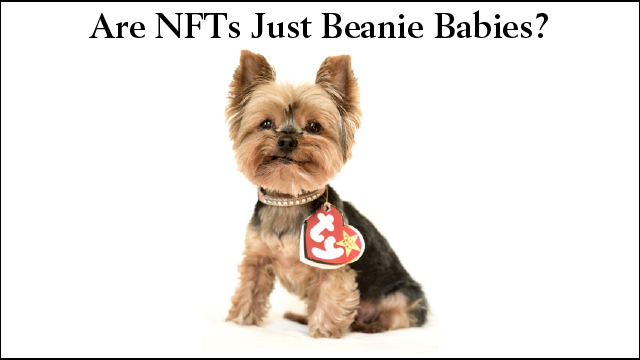
There existed for a brief period of time a restaurant called GarfieldEats. It doesn’t exist in the physical world anymore. ViacomCBS decided not to renew its license as the pandemic hit restaurants hard and the market just wasn’t there for vaguely Garfield-shaped pizzas.
However, the creator of GarfieldEats doesn’t see this as the end – far from it. Instead, creator Nathen Mazri has pivoted GarfieldEats into a series of budget-conscious NFTs created by an artificial intelligence that will live in the metaverse[1]. (There’s a sentence that would make the Cat in the Hat proud.)
The legality of selling merchandise without a license aside, it’s obvious why this would appear to be easy money. Every other week there’s a story about a new NFT millionaire, sometimes by accident. For example, one of the hottest commodities[2] is the Bored Ape Yacht Club. It’s a series of NFTs all depicting a cartoon ape dressed in different outfits, all while looking bored. They’ve routinely sold for six figures. Seems like somebody could put those three letters on anything and then buy an umbrella because it’s about to start raining money.
Alas, that’s not how this story goes.
GarfieldEats NFTs were first offered at $100. Days turned to weeks and nobody bought them. Only when $1 NFTs were offered did a few start selling.
Using one example is unfair, but it begs the larger question – with so many NFTs making headlines for fetching thousands, sometimes millions, of dollars, how long can the market last?
Perhaps the answer lies in 1999 when Beanie Babies were all the rage.
The creator of Beanie Babies, Ty Warner, turned the toys into an empire by utilizing a very simple tool – scarcity. He didn’t put Beanie Babies in big chains like Toys-R-Us, instead choosing local mom and pop shops. He partnered with McDonald’s to put them in Happy Meals®. He would “retire” characters by stopping the manufacturing of a line after a certain period of time.
Boy howdy did it work.
The quest to obtain Beanie Babies was so desperate that children were trampled, smuggling rings concocted, and murders committed[3]. Prices on the secondary market went sky high. Beanie Babies weren’t just floppy plush toys– they were investments. Roth IRA? 401(k)? Pssht! The real money was in Knuckles the Pig, Lips the Fish, and Paul the Walrus (not all the names were winners).
Until it wasn’t. Then the bubble went pop. In retrospect, the Beanie Baby craze was spurred on by wild speculation and unsupported, almost desperate, optimism.
While bubbles involving toys are not widely studied, asset bubbles are.
Professors David Tuckett and Richard Taffler’s 2005 study on the Dot Com bubble approaches the subject from a psychoanalytical angle which can also be applied to nearly all bubbles. According to them, human beings will sometimes latch onto a new object, a “phantastic object,” which overwhelms the brain and distorts all sense of reason. Chasing these objects becomes a sort of quest with the end goal promising a transcendent level of satisfaction. Any rational thought gets thrown by the wayside in exchange for the pursuit. As others also race to the same goal, it further reinforces the legitimacy of the object in question[4].
Their paper builds on Charles Kindleberger’s theory of bubbles outlined in his book “Manias, Crashes, and Panics.” Kindleberger states that there are five stages to a bubble: 1) Displacement, 2) Boom, 3) Euphoria, 4) Profit Taking, and 5) Panic.
The NFT craze shares many things with Beanie Babies. Both sprouted up from small communities that bled over into the mainstream, saw/have seen their value skyrocket, and both share the necessary ingredient of scarcity. Beanie Babies were “retired,” NFTs are singular entities on a blockchain.
The unknown lies in NFTs’ future. Will they continue to have value past this, to borrow Kindleberger’s phrase, boom moment? As more and more of life is lived online, perhaps they will become status symbols for a gaming avatar, for example?
The difference may be perspective. Most Beanie Babies today have little value, a couple bucks maybe. However, find that one rare Batty the Bat with an extra foot due to a production error and that umbrella may get some use after all. Same could go for NFTs.
After all, as GarfieldEats proves – not all NFTs are created equally.
Joe Gallina
Joe has a degree in Finance from the University of Illinois at Chicago. Afterwards, he worked for Morgan Stanley and Bank of America/Merrill Lynch, obtaining both Series 7 and 66 licenses. At Merrill, he was on the self-directed side of the business, exposing himself to every aspect of the financial services industry.
Copyright © 2022 Protinus. All rights reserved.
[1]https://twitter.com/nathenmazri?ref_src=twsrc%5Etfw%7Ctwcamp%5Etweetembed%7Ctwterm%5E1477443776331329546%7Ctwgr%5E%7Ctwcon%5Es1_&ref_url=https%3A%2F%2Fwww.cracked.com%2Farticle_32355_the-garfield-restaurant-is-dead-but-lives-on-as-nfts-of-course.html
[2] https://www.theguardian.com/artanddesign/2022/jan/04/bored-ape-nft-art-eminem
[3] https://thehustle.co/the-great-beanie-baby-bubble-of-99/
[4] Tuckett, David and Taffler, Richard J., A Psychoanalytic Interpretation of Dot.Com Stock Valuations (March 1, 2005).
